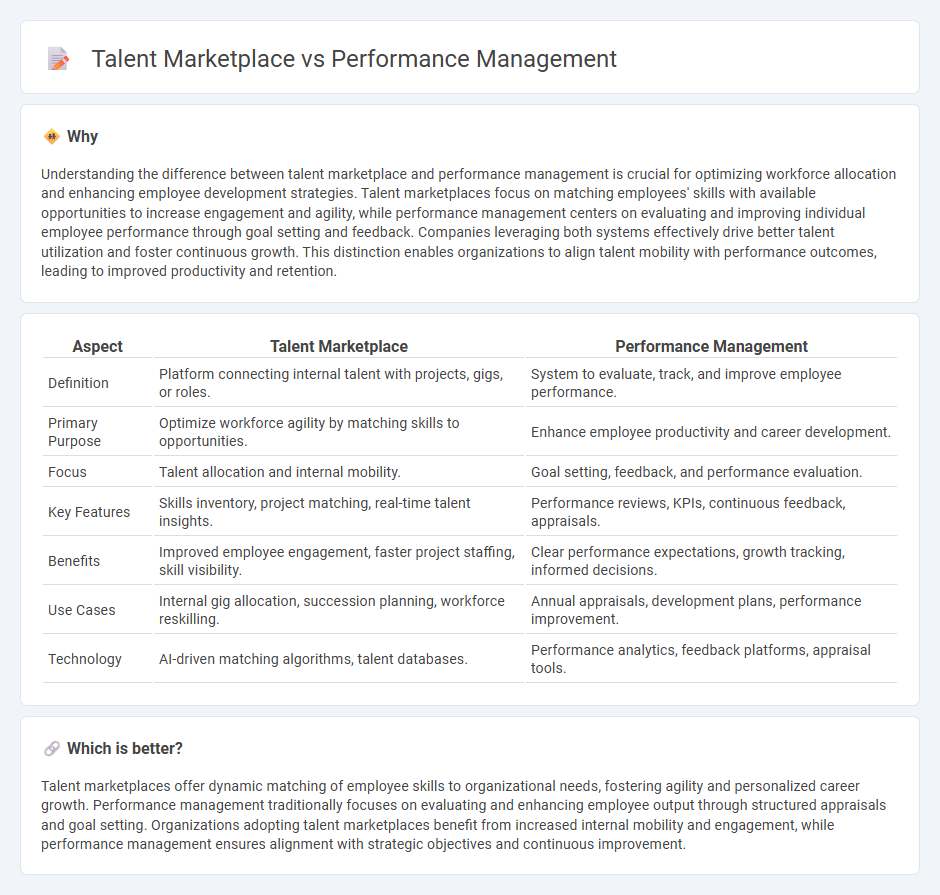
Talent marketplaces enable organizations to dynamically match employee skills with project needs, fostering agility and personalized career growth. Performance management focuses on evaluating and improving employee contributions through goal setting, feedback, and appraisals, driving organizational productivity. Discover how integrating talent marketplaces with performance management transforms workforce optimization.
Why it is important
Understanding the difference between talent marketplace and performance management is crucial for optimizing workforce allocation and enhancing employee development strategies. Talent marketplaces focus on matching employees' skills with available opportunities to increase engagement and agility, while performance management centers on evaluating and improving individual employee performance through goal setting and feedback. Companies leveraging both systems effectively drive better talent utilization and foster continuous growth. This distinction enables organizations to align talent mobility with performance outcomes, leading to improved productivity and retention.
Comparison Table
| Aspect | Talent Marketplace | Performance Management |
|---|---|---|
| Definition | Platform connecting internal talent with projects, gigs, or roles. | System to evaluate, track, and improve employee performance. |
| Primary Purpose | Optimize workforce agility by matching skills to opportunities. | Enhance employee productivity and career development. |
| Focus | Talent allocation and internal mobility. | Goal setting, feedback, and performance evaluation. |
| Key Features | Skills inventory, project matching, real-time talent insights. | Performance reviews, KPIs, continuous feedback, appraisals. |
| Benefits | Improved employee engagement, faster project staffing, skill visibility. | Clear performance expectations, growth tracking, informed decisions. |
| Use Cases | Internal gig allocation, succession planning, workforce reskilling. | Annual appraisals, development plans, performance improvement. |
| Technology | AI-driven matching algorithms, talent databases. | Performance analytics, feedback platforms, appraisal tools. |
Which is better?
Talent marketplaces offer dynamic matching of employee skills to organizational needs, fostering agility and personalized career growth. Performance management traditionally focuses on evaluating and enhancing employee output through structured appraisals and goal setting. Organizations adopting talent marketplaces benefit from increased internal mobility and engagement, while performance management ensures alignment with strategic objectives and continuous improvement.
Connection
Talent marketplaces enhance performance management by matching employees' skills with project needs, fostering continuous development and goal alignment. Real-time data from talent marketplaces allows managers to track performance metrics and identify skill gaps, enabling targeted training and effective resource allocation. Integrating these systems drives organizational agility and optimizes workforce potential through personalized career growth paths.
Key Terms
**Performance Management:**
Performance management systematically evaluates employee contributions through goal setting, continuous feedback, and performance reviews to align individual objectives with organizational strategy. It emphasizes tracking key performance indicators (KPIs), employee development, and productivity enhancement to drive business results. Explore how integrating advanced performance management practices can transform workforce effectiveness and engagement.
Goal Setting
Performance management emphasizes structured goal setting aligned with organizational objectives to track and evaluate employee achievements effectively. Talent marketplaces focus on dynamic goal setting tied to project needs and individual skill development, enabling agile talent deployment. Explore how integrating both approaches can enhance organizational productivity and employee growth.
Feedback
Performance management centers on structured feedback mechanisms such as regular reviews, goal-setting sessions, and continuous coaching to enhance employee productivity and development. Talent marketplaces leverage real-time feedback within internal gig platforms to dynamically match skills with project opportunities, fostering agility and personalized growth. Explore how integrating these feedback-driven approaches can transform workforce engagement and business outcomes.
Source and External Links
What Is Performance Management? The Complete Guide - Performance management is an ongoing process where managers and employees communicate regularly to assess job responsibilities, set goals (including SMART, development, and stretch goals), and provide continuous feedback to foster improvement and align individual performance with organizational objectives.
Performance Management - KU's Human Resources - It is a continuous cycle of clarifying job roles, setting expectations, developing plans, and conducting regular feedback sessions (initial goal-setting, quarterly check-ins, and a final evaluation) to optimize individual performance and ensure alignment with organizational goals.
Performance Management Cycle - OPM - The performance management cycle consists of planning work and setting goals, continually monitoring progress, developing employee skills, periodically rating performance, and rewarding good performance to support both individual and organizational success.
 dowidth.com
dowidth.com